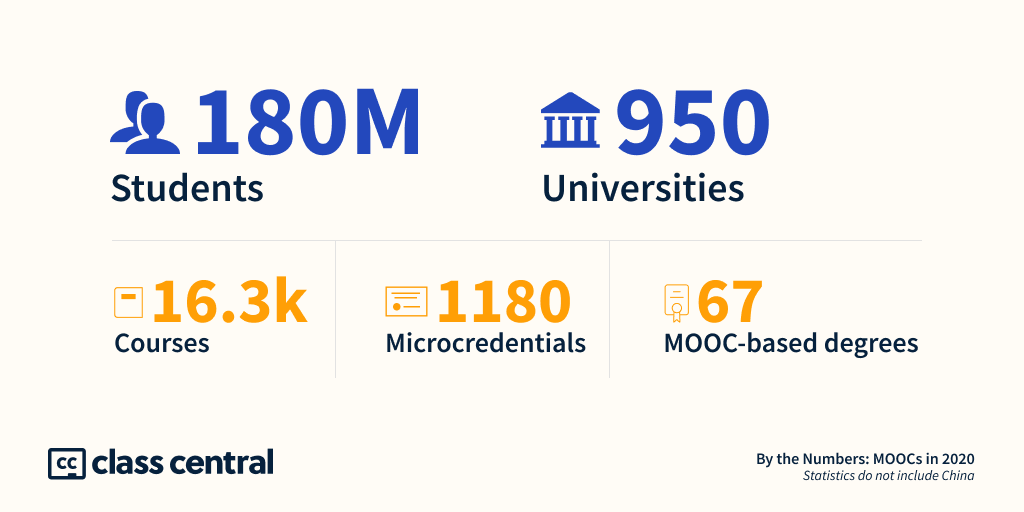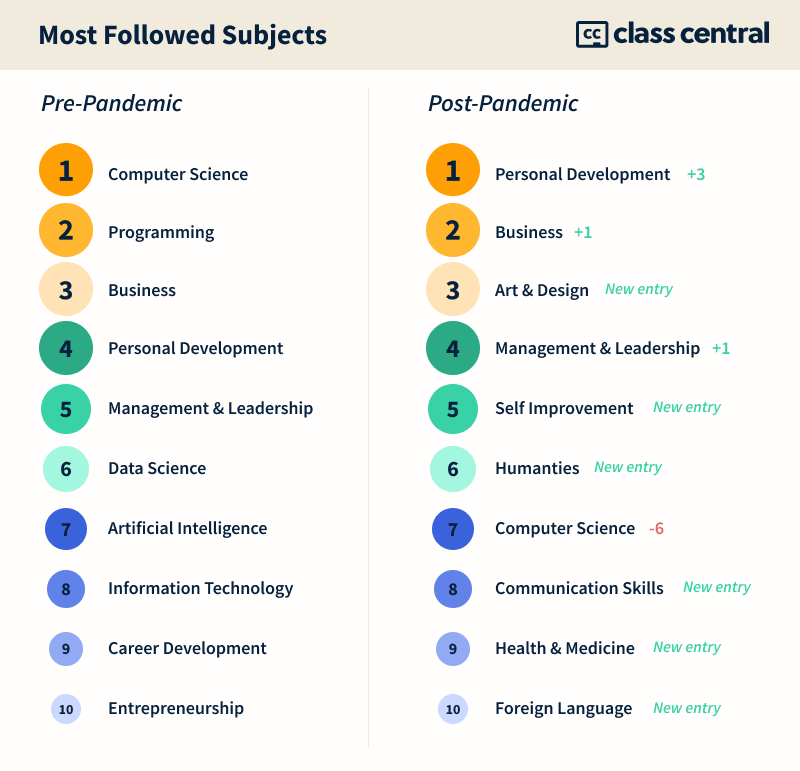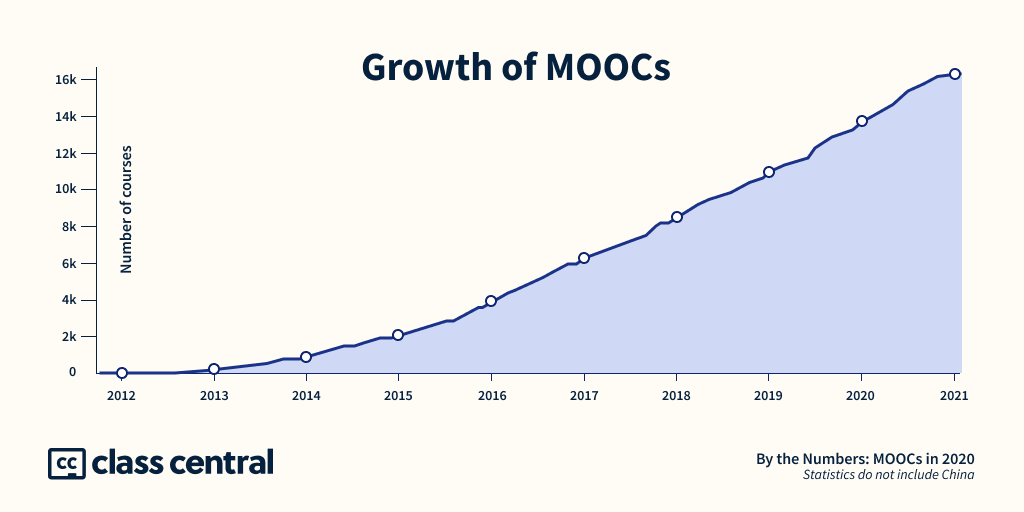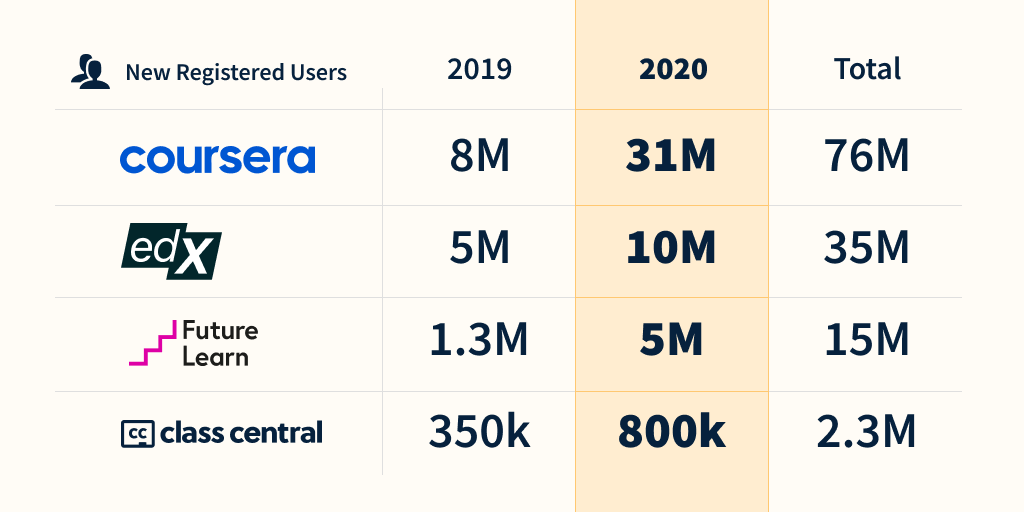The Second Year of The MOOC: A Review of MOOC Stats and Trends in 2020
In 2020, the big MOOC providers got bigger, and the biggest one pulled further ahead of the rest.
Of all the learners that ever registered on a MOOC platform, one third did so in 2020, making 2020 MOOCs’ most consequential year since the “Year of the MOOC”.
In 2020, the big MOOC providers got bigger, and the biggest one pulled further ahead of the rest.
Now in its ninth year, the modern MOOC movement has crossed 180 million learners, excluding China1. Class Central data shows that providers launched over 2800 courses, 360 microcredentials, and 19 online degrees.

Quarantine Boost
In late February – early March, as universities worldwide were going remote due to the pandemic, I noticed that MOOCs weren’t part of the conversation.
But on March 15, Class Central saw a large influx of visitors. This was the weekend when quarantine measures went into effect in many countries around the world.
As millions suddenly found themselves with free time on their hands, many turned to online courses — especially, to free courses. This phenomenon was compounded by media worldwide compiling lists of “free things to do during lockdown”, which tended to include MOOCs.
The last 48 hours have been crazy.
More than a million learners have used @classcentral to find their next course.
In one day we received more traffic than the entire month of February. pic.twitter.com/e0kIVE1NO3
— Dhawal Shah (@dhawalhshah) March 17, 2020
Within two months, Class Central had received over 10 million learners and sent over 6.3 million clicks to MOOC providers. These learners also turned out to be more engaged than usual. In April 2020, Coursera, edX, and FutureLearn attracted as many new users in a single month as they did in the entirety of 2019.
Big MOOC providers responded to the pandemic by offering free courses about COVID-19, free certificate courses, and free catalog access to university students. Their full pandemic response is described here.
Class Central also compiled a list of 90 online course providers that offered free learning opportunities during the pandemic.
As a result, MOOCs during the pandemic reached a broader population with wider interests.

Data collected by Class Central show that pre-pandemic, technology-related subjects were the most popular: the ten most-followed courses were all career-focused. Post-pandemic, interest in soft skills and general topics increased.
The most popular course during the pandemic turned out to be Yale University’s The Science of Well-Being, with over 2.5 million enrollments in 2020.
One-fifth of the 100 most popular courses launched in 2020 are directly related to COVID-19. The top course, with over 1 million enrollments, is Johns Hopkins’ COVID-19 Contact Tracing. It’s followed by Harvard’s Mechanical Ventilation for COVID-19, with 300K enrollments.
The Second Year of the MOOC
| 2012 | 2020 | |
| Funding | ~$100 million | ~$900 million |
| Learners | 2 million | 180 million |
| University Partners | 40 | 950 |
| Courses | 250 | 16.3K |
| Revenue | 0 | Hundreds of millions |
Over the years, providers have become better at monetizing their content. But when it comes to gaining new users, they’d hit a wall: in 2019, they attracted a similar number of users as in 2018.
The pandemic helped them break through that wall.
2012, the “Year of the MOOC” was characterized by media hype. Many claims and predictions were made. I went back and read a few:
- Udacity co-founder Sebastian Thrun said “The vision is: change the world by bringing education to places that can’t be reached today.” But Udacity has since largely pivoted toward corporate education.
- Coursera co-founder Daphne Koller said that “the tsunami [of MOOCs] is coming whether we like it or not. You can be crushed or you can surf and it is better to surf.”
- Edtech writer Michael Horn said that Coursera or edX MOOCs could be combined into “coherent degrees that’ll cost one thousand or two thousand dollars.”
Most of these predictions haven’t materialized.
But it did lead to FOMO in higher education institutions and Silicon Valley, prompting them to invest capital and resources to launch free online courses without a concrete plan to recoup costs or earn a return.
Nine years later, the impetus generated by the Year of the MOOC has borne fruit: combined, providers are making hundreds of millions every year.

This is why I’m calling 2020 the Second Year of the MOOC. I believe it will give MOOCs a platform on which providers will build for the years to come.
The quarantine boost produced over a year’s worth of users and revenue in just a couple of months. We experienced this ourselves: of all the people who’ve used Class Central since its inception nine year ago, 40% (18+ million) did so for the first time this year.
While the boost is nowhere near its March-April peak, it has drastically impacted providers’ fortunes. It allowed them to skip forward: they’re now where they would have expected to be two years down the road, in the absence of pandemic.
Coursera has already capitalized on these circumstances: it doubled its valuation and is considering going public in 2021.
You can find a complete overview of how MOOCs did this year in By The Numbers: MOOCs in 2020. And you can learn more about individual MOOC providers in Class Central’s 2020 end-of-year analyses:
- Coursera’s 2020: Year in Review
- EdX’s 2020: Year in Review
- FutureLearn’s 2020: Year in Review
- Udacity’s 2020: Year in Review
[1] We decided to leave China out of our analysis because, as we learned more about Chinese online education, we realized that the metrics we’d like to present are: (1) sometimes unavailable, (2) sometimes available but impossible to validate to the extent we’d like, (3) sometimes reflect a view too narrow to adequately capture the overall state of MOOCs in China.








Christy Read
As a mentor on Coursera, my colleagues and professors have all been overwhelmed by the number of people chasing free certificates on Coursera’s badly thought-out scheme. The cheating, plagiarism, flooding the forums with unnecessary requests for reviews. Hundreds a week. It was absolutely awful and even with one of my profs requesting his course to be withdrawn from it, it did not work.
Professors and mentors were not told about this scheme being introduced.
One of the things the students did was creating WhatsApp groups where the gave each other good grades.
Christy Read
Moe
WOW, that’s shameful!
I hope the acts of these students don’t affect the work of the other hardworking learners.
Lauren
I actually got refunded for a Coursera Specialization because there was so much cheating going on. I was one of the few fools that took the class seriously and invested time and energy into the assignments, while people were in the forums asking for test answers and submitting blank assignments. Once I pulled up an assignment to review and it was my own submitted by another student, I had had enough.
Della
I believe we could see this issue in a long-term view, either as an instructor or as a learner. As an online learner, I took online courses because the content and skills I learned will benefit my individual development. Those who cheated are and will “fool” themselves when they need those skills and knowledge. As a teacher, the course is worth it because it helps learners, and it is necessary for instructors to work with researchers, designers, and learners to solve this issue, hopefully in the near future. There are still many ethical issues left to be studied.
Dr Balasubramanyam Chandramohan, PhD
Helpful overview of the trends.
Do you have the breakdown by language used in the MOOCs? Also, information on MOOCs by country/region, if avaialable, please.
Della
I am also interested in the demography of MOOC learners, if available. Thank you for bringing this up.
amin
Thank you for this helpful report